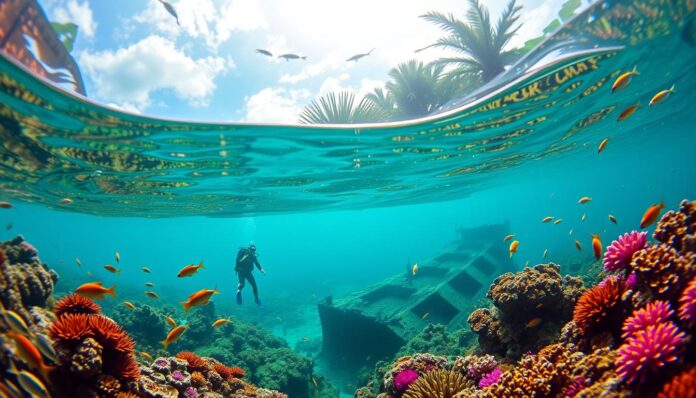| Best Time to Travel | March to May, and October to November |
| What to Expect | Warm water, clear visibility, diverse marine life |
| Diving Conditions | Year-round, but best from March to May and October to November |
| Marine Life | Nudibranchs, seahorses, frogfish, turtles, stingrays, sharks |
Have you ever wondered what lies beneath Singapore’s busy streets? Scuba diving in Singapore reveals a hidden underwater world. It’s a place full of marine wonders that challenge what you thought you knew about this urban island.
Singapore’s diving scene is a mix of colorful marine life and exciting underwater adventures. The city’s waters are clear, and the marine life is diverse. This makes diving in Singapore a unique experience that few people know about.
Scuba diving in Singapore is more than just a sport. It’s a journey into a secret world. The city’s location means you can dive all year, with the best times from March to November. During these months, divers can enjoy experiences that are as good as those in famous diving spots.
Key Takeaways – Scuba Diving in Singapore
- Singapore offers unique underwater experiences year-round
- Dive sites range from coral reefs to historic shipwrecks
- Best diving months are between March and November
- Suitable for both beginners and experienced divers
- Marine biodiversity is surprisingly rich around Singapore
- Affordable diving courses are widely available
- Multiple marine parks provide excellent diving locations
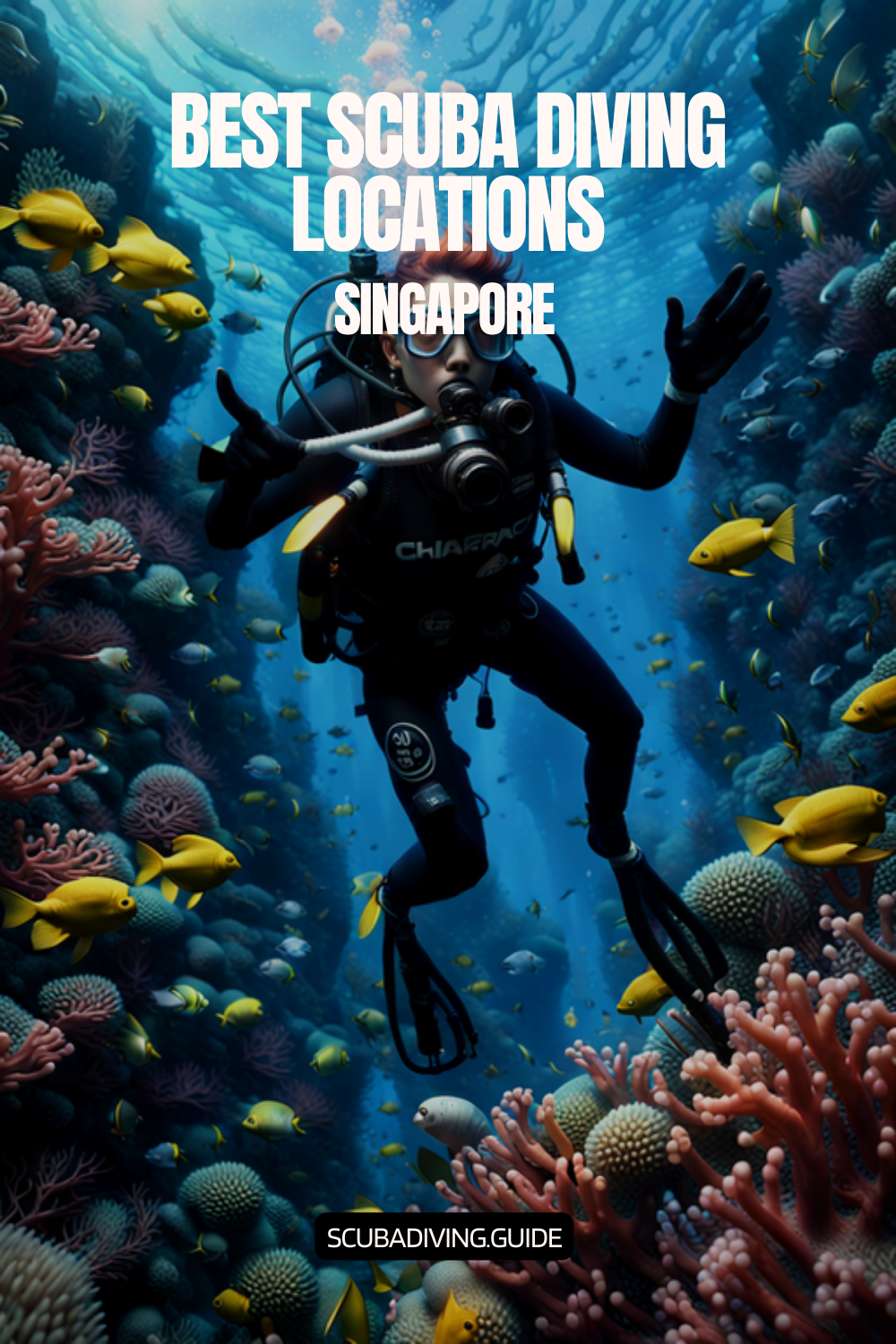
Overview of Scuba Diving in Singapore
Singapore offers a unique underwater experience that surprises many. The city-state’s maritime environment provides great opportunities for diving. Despite its urban landscape, divers can enjoy a thrilling marine adventure.
Underwater exploration in Singapore has become a thrilling marine adventure. The region’s location attracts both new and experienced divers. Its diverse marine ecosystem is a big draw.
Introduction to the Diving Scene
Singapore’s diving scene is remarkable:
- Diverse marine habitats are close by
- There are many dive sites around southern islands
- Water temperatures average 27º C
- Dive locations are less than an hour offshore
Importance of Marine Conservation
Marine conservation is key in Singapore’s underwater world. Divers play a big role in protecting and understanding local marine environments.
“Diving is not just an adventure, it’s a responsibility to preserve our marine world.”
| Dive Location | Key Characteristics | Marine Life |
|---|---|---|
| Pulau Hantu | Low visibility, muck diving | Nudibranchs, gobies, shrimps |
| Kusu Island | Sea turtle habitat | Anemonefish, lobsters |
| Pulau Jong | Pristine diving, strong currents | Parrotfish, black-tip reef sharks |
Underwater exploration in Singapore is growing. It attracts divers with its unique marine biodiversity and conservation efforts.
Popular Diving Locations Around Singapore
Singapore has a hidden underwater world for scuba diving fans. Despite being a bustling city, it has many great diving spots. These places offer unique marine experiences close to the city.
The tropical waters around Singapore are full of marine life. Divers can explore everything from calm beaches to vibrant coral reefs. These spots offer a variety of underwater adventures.
East Coast Park: Beginner’s Paradise
East Coast Park is perfect for new divers. Its calm waters and sheltered location make it great for beginners. Here, divers can find:
- Gentle underwater currents
- Moderate marine biodiversity
- Easy access from urban areas
Pulau Hantu: The Ghost Island Experience
Pulau Hantu, or “Ghost Island,” is just 30 minutes by boat from Singapore. It’s a small island with amazing marine life.
“Pulau Hantu offers divers a glimpse into Singapore’s hidden underwater treasures.” – Local Diving Expert
| Location Details | Marine Life Highlights |
|---|---|
| Distance from Singapore | 30-minute boat ride |
| Marine Species | Seahorses, Clownfish, Nudibranchs |
| Diving Difficulty | Intermediate |
Sisters’ Islands: Marine Park Wonder
Sisters’ Islands is Singapore’s first marine park. It’s a conservation success and offers great diving. Divers can see diverse coral and maybe even sea turtles. The site has:
- Protected marine environment
- Rich biodiversity
- Educational conservation opportunities
When diving in Singapore, the best times are April to July. This is when the water is clearest and warmest.
Dive Sites for Beginners
Starting your scuba diving journey can be thrilling yet scary. Singapore is a great place for new divers to explore the underwater world. It offers safe and welcoming spots for those diving for the first time.
What to Expect as a Beginner
First-time divers can look forward to a well-structured learning experience. Scuba Certification Courses Singapore include:
- Classroom theory sessions
- Pool training for basic skills
- Open water dives under professional supervision
- Comprehensive safety instruction
“Every expert diver was once a beginner. Your journey starts with understanding and respecting the underwater environment.”
Recommended Dive Centers
Several top dive centers in Singapore focus on beginner courses. Look for places with PADI and SSI accreditation. These centers provide detailed training to help you build confidence and skills.
Safety Tips for New Divers
Safety is key in scuba diving. Here are some important tips:
- Always dive with a certified instructor
- Check equipment thoroughly before diving
- Learn and practice emergency procedures
- Stay within your skill level
- Listen carefully to professional guidance
Remember, mastering scuba diving takes time and patience. Each dive is an opportunity to learn and grow in your underwater skills.
Advanced Diving Spots
Wreck Diving Singapore offers seasoned divers an extraordinary underwater adventure. They explore fascinating maritime remnants. These treasures unlock historical narratives and marine ecosystems.
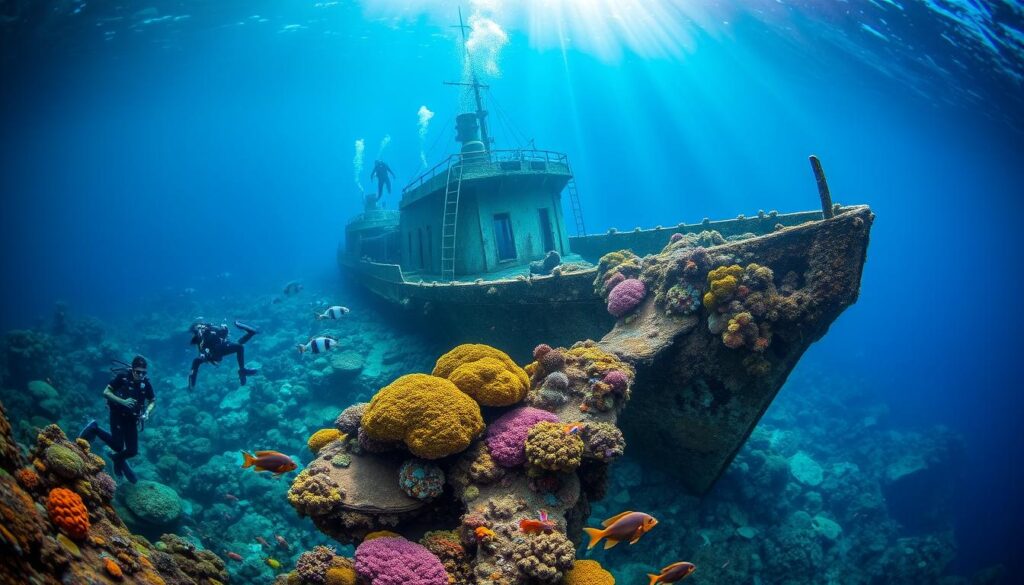
Experienced divers find Singapore’s wreck diving sites captivating. These locations demand technical skills. They offer unique marine encounters.
The Junk Wreck: A Maritime Time Capsule
The Junk Wreck is a top Wreck Diving Singapore spot. It’s an artificial reef, attracting diverse marine creatures. Divers get a glimpse into maritime history.
- Depth range: 18-25 meters
- Marine life diversity: High
- Recommended certification: Advanced Open Water
- Best visibility: 3-5 meters
The N Yong II Wreck: Underwater Historical Landmark
The N Yong II Wreck is another great spot for advanced divers. It’s a thriving marine habitat. It shows nature’s regenerative power.
| Dive Characteristics | Details |
|---|---|
| Maximum Depth | 22 meters |
| Water Temperature | 28-30°C |
| Recommended Experience | Advanced certification |
Exploring Pulau Jerejak: The Advanced Diver’s Challenge
Pulau Jerejak is a challenge for skilled divers. It has complex underwater topography and limited visibility. Divers need excellent navigation skills and awareness.
“Diving is not about being underwater. It’s about being comfortable in an environment completely different from your own.” – Unknown Diving Expert
For Wreck Diving Singapore, proper training and respect for marine environments are key. Always prioritize safety, maintain excellent physical condition, and dive within your skill level.
Unique Marine Life You Might Encounter
Singapore’s waters are full of marine life, giving divers a chance to see the vibrant underwater world. These tropical waters, just 1.5 degrees north of the Equator, are perfect for many marine organisms.
The marine ecosystem here is very rich. Water temperatures range from 25 to 30 degrees Celsius all year. This makes it a great place for many marine species to live.
Coral Species in Singapore
Divers can see a beautiful underwater world with both hard and soft corals. The coral diversity is amazing, with:
- Barrel sponges
- Sea fans
- Black corals
- Brain corals
- Plate and branching hard corals
Notable Fish Species
There are over 100 reef fish species in Singapore’s waters. This creates a colorful underwater scene. Divers can see:
- Anemone fish
- Damselfish
- Angelfish
- Parrotfish
- Sweetlips
- Fusiliers
Fascinating Marine Organisms
There’s more to see than just fish and corals. Marine Life in Singapore Waters includes:
- Nudibranchs with vibrant colors ranging from bright yellows to deep blues
- Seahorses at Pulau Hantu
- Nurse sharks
- Resident sea turtles
“Singapore’s marine ecosystem is a hidden underwater world waiting to be explored by passionate divers and marine enthusiasts.”
Singapore has over 250 hard coral species and 200 sponge varieties. It offers a unique marine exploration experience that surprises and delights underwater adventurers.
Scuba Diving Certifications
In Singapore, diving fans can find many ways to dive into underwater adventures. Whether you’re new to diving or want to improve your skills, there are many options. The city-state has certifications for all levels of experience.
Overview of Certification Levels
Scuba diving certifications in Singapore follow a clear path:
- Open Water Diver: This is the first step, teaching basic diving skills.
- Advanced Open Water: This level adds more skills and knowledge.
- Rescue Diver: Here, you learn how to handle emergencies and stay safe.
- Professional levels: For those aiming to become a Divemaster or Instructor.
Recommended Certification Agencies
Singapore is home to several well-known diving certification agencies:
- PADI (Professional Association of Diving Instructors)
- SSI (Scuba Schools International)
- SDI (Scuba Diving International)
“The right certification can transform your underwater experience from novice to confident explorer.”
Choosing the Right Course
When picking Scuba Certification Courses in Singapore, think about these things:
- What you want to achieve in diving
- How much time you have
- What you can spend
- Any special interests, like wreck diving or underwater photography
Places like Orpheus Dive offer training that’s tailored to you. They keep classes small, so you get the attention you need.
Essential Gear for Scuba Diving
Getting ready for an underwater adventure in Singapore means picking the right diving gear. Dive Equipment Rental Singapore has many options for both new and seasoned divers. They help you explore the marine world.
Renting vs. Buying Gear: Making the Right Choice
Divers have to decide between renting or buying gear. Renting Dive Equipment Rental Singapore has its benefits:
- Lower upfront costs
- Access to high-quality, well-maintained equipment
- Opportunity to test different gear before purchasing
- Convenience for occasional divers
Must-Have Equipment for Your Dive
Having the right gear is key for a safe and comfortable dive. Here are the essentials:
- Mask: About 80% of divers like silicone skirt masks for better comfort and seal
- Fins: Pick between full-foot and open-heel based on the water temperature
- Wetsuit: Important for keeping warm, with thickness depending on the water
- Regulator: Essential for breathing underwater, affects safety
Optional Accessories to Enhance Your Dive
These accessories can make your dive better, even if they’re not required:
- Dive computer (reduces underwater anxiety for 75% of divers)
- Underwater camera
- Surface marker buoy
- Dive bag for equipment storage
“Proper equipment selection is the key to a safe and enjoyable diving experience.” – Professional Diving Instructor
When looking at Dive Equipment Rental Singapore, focus on quality and fit. The right gear helps avoid fatigue and ensures comfort during your dive.
Best Time to Dive in Singapore
Scuba diving in Singapore is a year-round adventure. The tropical weather keeps diving conditions steady. This makes it a top spot for those who love the sea.
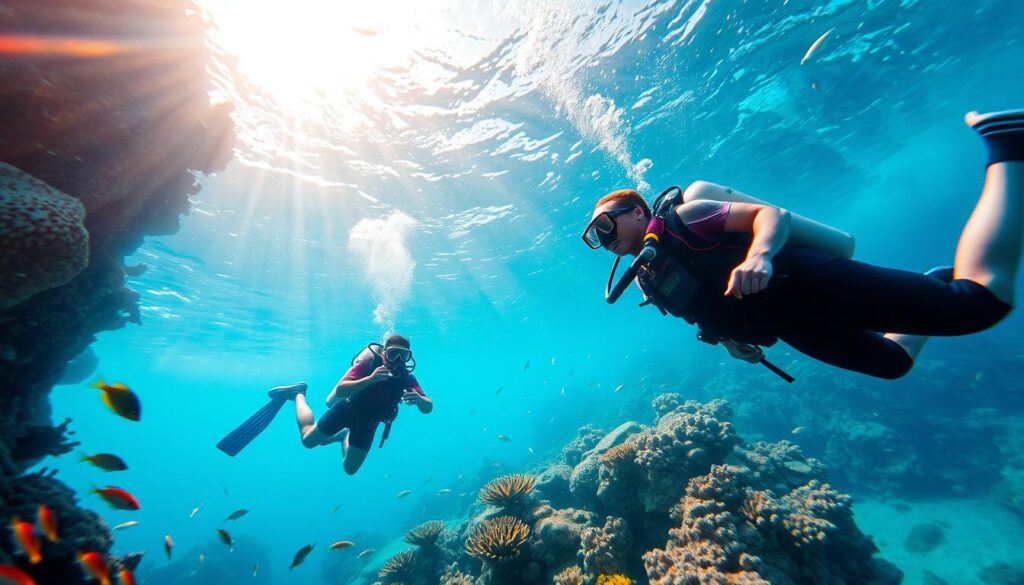
From March to November, Singapore’s waters are perfect for diving. The warm water, around 27°C (80°F), is ideal for all divers. Each season offers something unique for underwater explorers.
Climate and Water Conditions
Knowing the seasons is key for diving in Singapore. Here’s what you need to know:
- March to May: Inter-monsoonal period with better visibility
- June to August: Stable sea and little rain
- September to November: Good diving with diverse marine life
- December to February: Rainy and less clear
Seasonal Highlights
Every month in Singapore offers something special for divers:
- March to May: Best for seeing marine life
- June to August: Consistent diving conditions
- September to November: Diverse marine encounters
“The underwater world of Singapore reveals its secrets to those who dive with patience and respect.”
Diving in Singapore is possible all year, but the best times are during the dry months. Always check the weather and tides before diving.
Dive Tours and Packages
Exploring Singapore’s underwater world needs careful planning. Liveaboard dive trips Singapore are perfect for both new and seasoned divers. They offer a chance to see the region’s marine wonders.
Group vs. Private Dive Tours
Divers have two main tour choices:
- Group Tours: More affordable and social
- Private Tours: Personalized experience with customized itineraries
What to Look for in a Dive Package
When picking a dive package, look at these key points:
- Included equipment
- Transportation arrangements
- Safety protocols
- Marine conservation practices
Popular Dive Operators
Singapore has many top dive operators for Liveaboard dive trips Singapore. MV Nautica is known for its detailed packages:
- 3D2N weekend trips starting from SGD 559
- Weekly trips from January to December
- Up to 6 guided boat dives
“Choose a dive package that matches your skill level and adventure spirit!” – Professional Diving Instructor
Pulau Tioman is a top spot for diving, open from March to October. A 2-day package starts at SG$649, with up to 6 dives.
Environmental Considerations
Scuba diving in Singapore means we must protect the marine ecosystems. The underwater world around Singapore is delicate and needs our care. We must dive mindfully to preserve it.
Impact of Diving on Marine Ecosystems
Divers are key in protecting Marine Life in Singapore Waters. But, if diving is not done right, it can harm coral reefs and habitats. Some big concerns are:
- Physical damage to coral structures
- Disruption of marine organism habitats
- Potential introduction of pollutants
Sustainable Diving Practices
Responsible diving can help reduce harm to the environment. The Singapore Sports Safety Division suggests a few ways to do this:
- Maintain excellent buoyancy control
- Avoid touching marine life
- Use environmentally friendly diving equipment
Conservation Efforts in Singapore
The diving community in Singapore is working hard for marine conservation. The Sustainable Diving Think Tank workshop at ADEX Singapore shows some of these efforts:
| Conservation Initiative | Impact |
|---|---|
| Coral Monitoring Surveys | 2-3 surveys per week during low season |
| Pre-Dive Briefings | Reduced diver-related reef damage from 37% to 7% |
| Waste Reduction Strategies | Implementing compost systems and reusable materials |
“Small collective efforts can create significant positive environmental impacts.” – ADEX Singapore Conservation Team
Divers should support these efforts by diving responsibly. They can also join local marine protection initiatives.
The Scuba Diving Community
Scuba diving in Singapore is more than just exploring the sea. It’s about joining a lively community of marine lovers. Divers here share a special bond, all because of their passion for the ocean and its creatures.
Diving isn’t just for one person. It’s a chance to meet others who love the sea as much as you do. This shared love creates a strong bond among divers.
Joining Local Diving Clubs
Local diving clubs in Singapore offer great chances to dive. These clubs provide many benefits:
- Learning new skills together
- Going on group dives
- Meeting experienced divers
- Getting into exclusive diving events
Exciting Events and Meetups
The diving community in Singapore hosts many fun events. These events bring people together:
- Underwater conservation efforts
- Workshops on marine life photography
- Meetups for divers
- Programs to learn about marine ecosystems
Online Resources and Forums
Digital platforms have changed how divers connect and share knowledge. Online forums, social media, and websites help divers in Singapore. They can share tips, plan dives, and make new friends.
“The ocean stirs the heart, inspires the imagination and brings eternal joy to the soul.” – Robert Wyland
Whether you’re new to diving or have years of experience, Singapore’s diving community welcomes you. It’s a chance to learn, explore, and connect with others who love the sea as much as you do.
Tips for First-Time Divers
Starting your first Scuba Diving in Singapore adventure is both thrilling and a bit scary. This guide will help you get ready for a safe and fun underwater journey.
Preparing for Your Dive
Getting ready for Scuba Diving in Singapore is key. Here are some important steps:
- Get a medical check-up to make sure you’re fit for diving
- Check if your diving certification is up to date
- If needed, take a refresher course (it costs about SGD 80)
- Learn to relax before diving to handle any nerves
Essential Pre-Dive Checklist
Before diving into Singapore’s waters, get ready mentally and physically:
- Drink plenty of water before diving
- Make sure you get enough sleep the night before
- Go over basic dive safety rules
- Double-check your gear
“Preparation is the key to a confident and enjoyable diving experience.”
Post-Diving Activities and Safety
After diving, follow these important steps for Scuba Diving in Singapore:
- Avoid flying for 18-24 hours after diving
- Stay hydrated and rest well
- Log your dive experience
- Take care of your equipment
Remember, the buddy system is very important. About 85% of diving incidents can be prevented if divers stay together and follow safety rules.
Fun Facts About Diving in Singapore
Exploring the underwater world in Singapore is truly fascinating. The island’s rich maritime history and unique marine life offer divers a wealth of discoveries.
Historical Dive Sites with Intriguing Stories
Singapore’s underwater landscape is home to remarkable historical artifacts. There are several dive sites with compelling stories of maritime history:
- The Codd Wreck, a 100-year-old steel wreck covered in coral
- Wreck diving opportunities in Batam and Bintan islands
- Ancient trade route artifacts hidden beneath the waves
Cultural Significance of Diving
Diving in Singapore has evolved from a practical skill to a popular recreational activity. Local communities now see underwater exploration as both a sport and a way to protect marine life.
*Diving connects us to the hidden world beneath the waves, revealing Singapore’s marine secrets.*
Fascinating Marine Life Trivia
| Marine Species | Interesting Fact |
|---|---|
| Batfish | Commonly found around Pulau Mapor |
| Cuttlefish | Known for remarkable camouflage abilities |
| Blue Spotted Rays | Large specimens frequently observed in local waters |
Underwater exploration in Singapore is always revealing new marine biodiversity. With 350 parks and many nature reserves covering 56% of the island, there’s always more to discover for divers and marine enthusiasts.
Singapore Recommended Scuba Diving Itinerary
To make the most of your scuba diving adventure in Singapore, it’s essential to plan a well-rounded itinerary that showcases the country’s top dive sites and provides a diverse range of underwater experiences. Here’s a recommended scuba diving itinerary that combines the best of Singapore’s underwater wonders:
Day 1: Arrival and Orientation
Upon arriving in Singapore, settle into your accommodation and visit a local diving center to complete any necessary paperwork and equipment arrangements. Take this opportunity to meet with instructors or dive guides who can provide an orientation to the local diving scene, discuss safety protocols, and answer any questions you may have. Familiarize yourself with the diving facilities and services available at the center.
Day 2: Discover Pulau Hantu
Begin your diving adventure with a trip to Pulau Hantu, one of Singapore’s premier dive sites. Join a guided dive excursion or opt for a shore dive if you prefer independent exploration. Immerse yourself in the crystal-clear waters teeming with marine life, including seahorses, nudibranchs, and colorful coral formations. Take your time to explore the multiple dive sites around the island, each offering its own unique underwater landscapes.
Day 3: Explore Sisters’ Islands
Embark on a diving expedition to Sisters’ Islands, a marine park known for its thriving coral reefs and rich marine biodiversity. Dive alongside majestic reef sharks, encounter a wide variety of fish species, and marvel at the vibrant colors of the underwater world. Take breaks between dives to visit the Sisters’ Islands Marine Park Public Gallery, where you can learn about the conservation efforts in place to protect this precious ecosystem.
Day 4: Venture to Lazarus Island
Make your way to Lazarus Island, a hidden gem near Singapore’s mainland. Dive into its calm waters and explore the healthy coral reefs that surround the island. Encounter schools of colorful fish, graceful turtles, and perhaps even spot a stingray gliding across the sandy seabed. Take time to relax on the island’s pristine beaches and soak in the natural beauty that surrounds you.
Day 5: Dive the Wrecks of Pulau Jong
Embark on a unique diving experience at Pulau Jong, also known as Junk Island, where submerged wrecks create an artificial reef. Dive down to explore an old fishing trawler and a sunken barge, which now serve as habitats for a variety of marine life. Capture mesmerizing underwater photographs as you navigate through these fascinating wreck sites. Immerse yourself in the history and mysteries that lie beneath the surface.
Day 6: Venture to Raffles Lighthouse
Travel to Raffles Lighthouse, located at the southernmost tip of Singapore, and dive into the surrounding reefs and underwater rock formations. Be prepared for encounters with schools of snappers, batfish, and barracudas, as well as occasional sightings of reef sharks. The strong currents in this area make it ideal for experienced divers seeking a thrilling and challenging dive.
Day 7: Dive Sultan Shoal
Head to Sultan Shoal, off the western coast of Singapore, and explore its diverse marine ecosystem. Delight in the colorful soft and hard corals that carpet the seabed, providing a stunning backdrop for encounters with seahorses, cuttlefish, and an array of reef fish. Dive the Sultan Shoal Lightship wreck, which has transformed into an artificial reef and is now home to a plethora of marine life.
Day 8: Wrap up with Kusu Island
Conclude your diving itinerary with a visit to Kusu Island, known for its rich cultural history and excellent dive sites. Dive into its surrounding reefs and marvel at the diversity of marine life, including parrotfish, angelfish, and intriguing moray eels. Enjoy the calm and tranquility of the island, explore its landmarks, and take time to reflect on the incredible underwater experiences you’ve had throughout your journey.
Remember, this itinerary is a suggestion, and you can customize it based on your preferences, available time, and diving experience. Be sure to check weather conditions, dive site accessibility, and any necessary permits or certifications required before embarking on each dive. Respect marine life and follow responsible diving practices to ensure the preservation of Singapore’s underwater treasures.
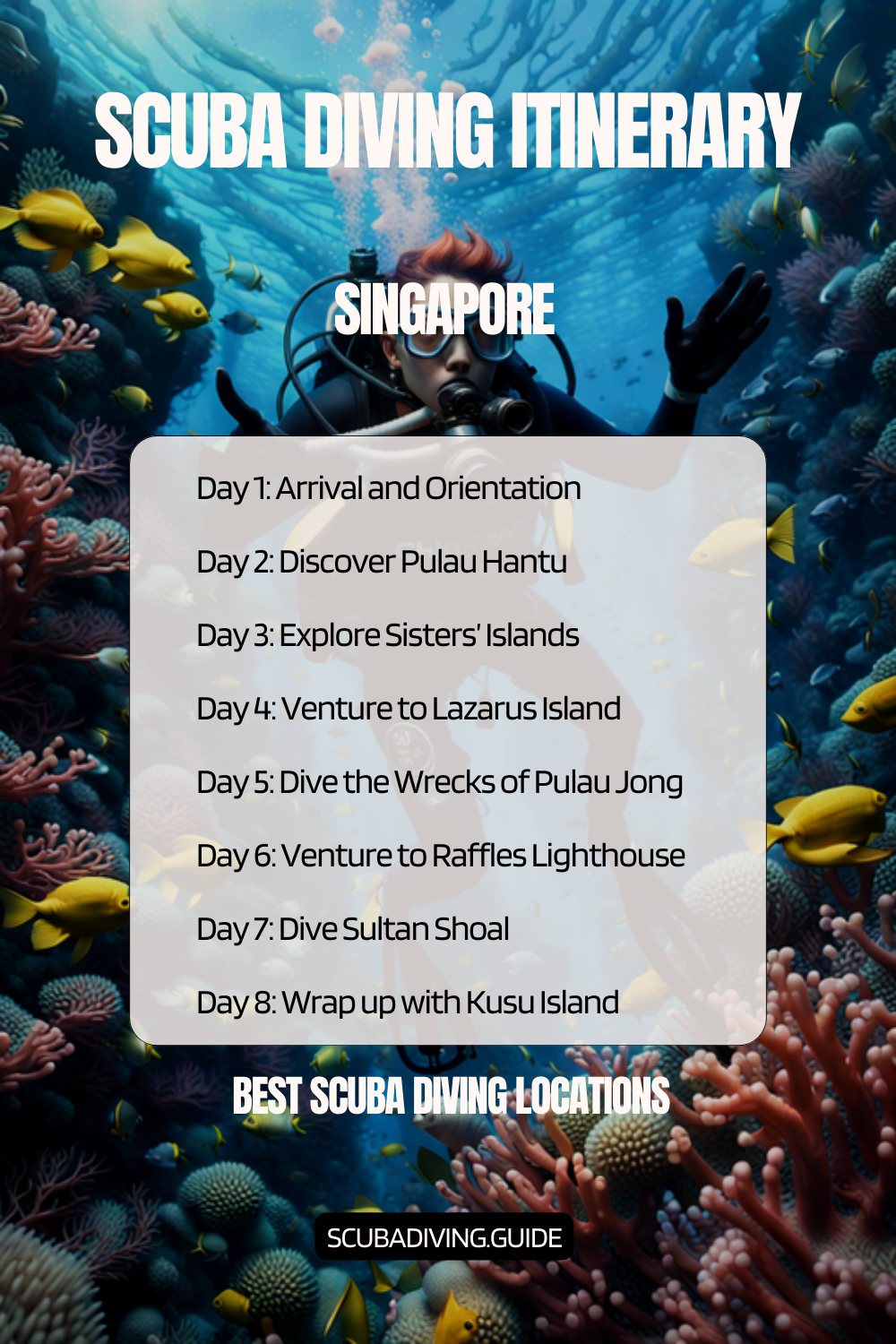
Other Countries to Consider
Conclusion: Dive into the Adventure
Scuba diving in Singapore is an amazing journey. It mixes adventure, learning, and caring for the environment. The city’s underwater world offers something for everyone, from newbies to seasoned divers.
Exploring Singapore’s seas is more than fun. It’s a way to connect with marine life and learn about local ecosystems. By diving, you help protect the ocean and its wonders.
Key Takeaways
Singapore’s diving scene is incredible for all levels. From colorful marine life to historic wrecks, each dive is unique. By diving responsibly and learning about the sea, you make a difference.
Get ready to dive into Singapore’s incredible underwater world. Every dive is a chance to discover, grow, and care for the ocean. Your scuba diving adventure starts now. Are you ready to explore?
FAQ – Scuba Diving in Singapore
Do I need prior experience to go scuba diving in Singapore?
No, you don’t need experience. Singapore has great spots for beginners. East Coast Park is perfect for first-timers, with expert instructors to guide you.
What certification agencies are available in Singapore?
You can get certified by PADI and SSI in Singapore. They offer courses from beginner to advanced levels. This includes wreck diving and underwater photography.
What marine life can I expect to see while diving in Singapore?
Singapore’s waters are full of life. You might see colorful fish, nudibranchs, sea turtles, and corals. Places like Pulau Hantu and Sisters’ Islands are great for spotting unique sea creatures.
When is the best time to go scuba diving in Singapore?
The best time is from March to November. The water is clearer, and the weather is better. December to February might be less good due to the monsoon.
Is scuba diving in Singapore expensive?
Prices vary based on your experience and the package. Beginner courses cost SGD 450-600. Single dives are SGD 100-150. Many places offer deals and rentals to save money.
What safety precautions should I take as a new diver?
Dive with a certified instructor and complete a training course. Get a medical check and use good equipment. Always dive within your limits and never alone. Dive centers focus on safety.
Can I rent diving equipment in Singapore?
Yes, you can rent equipment from most dive centers. They have everything from masks to full gear. It’s a good idea to try before you buy.
Are there any conservation efforts I can participate in?
Yes, there are many conservation programs. You can join reef clean-ups, monitor marine life, and more. Dive centers and clubs welcome volunteers.
What unique diving experiences does Singapore offer?
Singapore offers unique dives like shipwrecks and marine parks. You can dive in Pulau Jerejak’s underwater landscape. It’s a mix of urban and marine diversity.
How can I join the local diving community?
Join diving clubs, attend events, and use online forums. This way, you can meet other divers, share experiences, and learn about trips and conservation.
